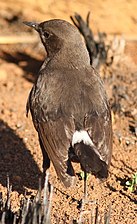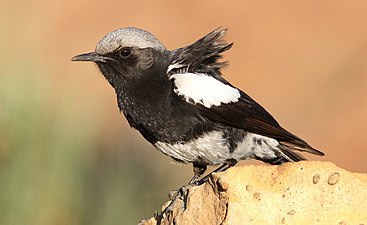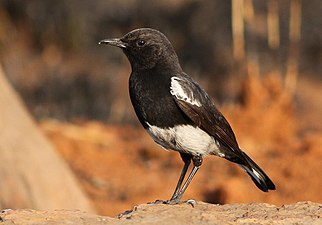| Mountain chat | |
|---|---|
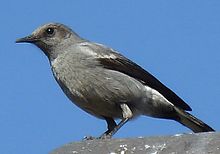
| |
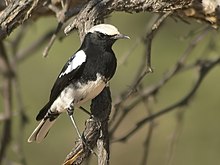
| |
| Males of the nominate (top) and westerly race, O. m. atmorii (bottom) | |
| Conservation status | |
 Least Concern (IUCN 3.1) | |
| Scientific classification | |
| Domain: | Eukaryota |
| Kingdom: | Animalia |
| Phylum: | Chordata |
| Class: | Aves |
| Order: | Passeriformes |
| Family: | Muscicapidae |
| Genus: | Myrmecocichla |
| Species: | M. monticola |
| Binomial name | |
| Myrmecocichla monticola (Vieillot, 1818) | |
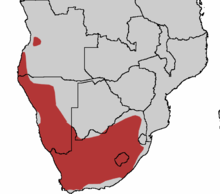
| |
| resident range | |
| Synonyms | |
|
Oenanthe monticola Viellot, 1918 | |
The mountain chat or mountain wheatear (Myrmecocichla monticola) is a small insectivorous passerine bird that is endemic to southwestern Africa.
Range and habitat
This non-migratory chat is resident in mountainous and rocky habitats in Namibia, Botswana, South Africa and southernmost Angola.
Description
The mountain chat is 18–20 cm long, and like other chats, it has a distinctive tail pattern, with a white rump and outer tail feathers. Its legs and pointed bill are black. The male is very variable in plumage, although the tail pattern and a white shoulder patch are always present. A white and black bird. The body plumage varies from pale grey to almost black, and it may or may not have a white crown to the head. The female is entirely dark brown apart from the white rump and outer tail.
Habits
The mountain chat's song is a clear melodic whistle interspersed with harsh chatters. It is monogamous and nests on the ground amongst rocks, laying 2-4 white eggs. It eats insects and berries.
Taxonomy
Along with other chats, this species was formerly classed as a member of the thrush family Turdidae, but based on studies published in 2004 and 2010, the Old World flycatcher family Muscicapidae is now preferred. The mountain wheatear was formerly placed in the genus Oenanthe. Molecular phylogenetic studies published in 2010 and 2012 found that the species was not closely related to the other members of Oenanthe and instead was genetically similar to the chats in the genus Myrmecocichla. The species was therefore assigned to Myrmecocichla.
Gallery
References
- BirdLife International (2016). "Myrmecocichla monticola". IUCN Red List of Threatened Species. 2016: e.T22710263A94241130. doi:10.2305/IUCN.UK.2016-3.RLTS.T22710263A94241130.en. Retrieved 12 November 2021.
- Sinclair, Ian; Ryan, Peter (2010). Birds of Africa south of the Sahara (2nd ed.). Cape Town: Struik Nature. p. 466. ISBN 9781770076235.
- Sangster, G.; Alström, P.; Forsmark, E.; Olsson, U. (2010). "Multi-locus phylogenetic analysis of Old World chats and flycatchers reveals extensive paraphyly at family, subfamily and genus level (Aves: Muscicapidae)". Molecular Phylogenetics and Evolution. 57 (1): 380–392. Bibcode:2010MolPE..57..380S. doi:10.1016/j.ympev.2010.07.008. PMID 20656044.
- Aliabadian, M.; Kaboli, M.; Förschler, M.I.; Nijman, V.; Chamani, A.; Tillier, A.; Prodon, R.; Pasquet, E.; Ericson, P.G.P.; Zuccon, D. (2012). "Convergent evolution of morphological and ecological traits in the open-habitat chat complex (Aves, Muscicapidae: Saxicolinae)". Molecular Phylogenetics and Evolution. 65 (1): 35–45. Bibcode:2012MolPE..65...35A. doi:10.1016/j.ympev.2012.05.011. PMID 22634240.
- Gill, Frank; Donsker, David, eds. (2016). "Chats, Old World flycatchers". World Bird List Version 6.2. International Ornithologists' Union. Retrieved 20 May 2016.
- Clement, Peter; Rose, Chris (2015). Helm Identification Guides: Robins and Chats. London: Christopher Helm. p. 645. ISBN 978-1-4081-5597-4.
- Ian Sinclair, Phil Hockey and Warwick Tarboton, SASOL Birds of Southern Africa (Struik 2002) ISBN 1-86872-721-1
External links
- Xeno-canto: audio recordings of the mountain wheatear
- Mountain chat - Species text in The Atlas of Southern African Birds.
| Taxon identifiers | |
|---|---|
| Oenanthe monticola | |
